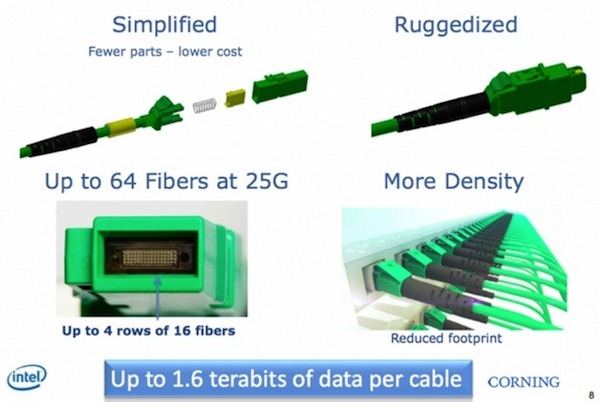Transforming Datacenters With 800 Gbps MXC Fiber Cables

Intel and several key partners are gearing up to release 800 Gbps optical cables, designed with new MXC connector technology, to support 21st century communications. The networking cables could be headed to a supercomputer or datacenter near you this year.
Developed by Corning at Intel's request, the multi-fiber connector employs a unique plug and receptacle design that enables increased density and lower cost. The connectors also have fewer parts than previous generations, which reduces manufacturing costs and makes them less prone to contaminants like dust. Other companies who have announced support for the technology include US Conec, TE Connectivity, and Molex.
Corning, the company that invented optical fiber in 1970, developed the new optical connector and multimode fiber technology to be compatible with Intel's Silicon Photonics (SiPh) module. As a joint solution, one MXC connector holds up to 64 fibers (half for transmitting and the other half for receiving), pushing 25 Gbps each, enabling 800 Gpbs data transfers in each direction, or an aggregate of 1.6 terabits per second.
As Intel fellow and general manager of the Silicon Photonics Operations Organization, Mario Paniccia, points out: "That's 1,600,000,000,000 bits per second. If you could transmit data at that speed, you could download a two-hour HD movie from iTunes (4 GB) in less than two seconds. With 2.5 quintillion bytes of data (1 followed by 18 zeroes) created every day, I doubt anyone questions that we are going to need the higher bandwidth that MXC cables provides in our 21st century data centers."
Intel's silicon photonics module together with Corning ClearCurve LX Multimode Fiber can drive cables as long as 300 meters (three times longer than current technologies), while the MXC connector can be used in tandem with Intel's silicon photonics technology for nearly all datacenter applications, including top-of-rack Ethernet switching, rack-to-end-of-row, storage interconnects, high performance computing, cloud computing, big data, and other new architectures.
This is a major breakthrough for Intel. Last year, the company debuted cable engineering samples that demonstrated 100 Gbps in each direction, using eight fibers. As EnterpriseTech has previously reported, Fujitsu has done a demonstration showing how MXC cables can be used to link systems and remote PCI-Express peripheral controllers together.
The new fiber and connector design will be part of Intel's Pretium EDGE SiPh Cable Assembly, available in fiber counts of 8, 16, 24, 32 and 64. Increasing density up to 64 fibers, each operating at 25 Gbps, scales data rates to 800 Gbps up and down, a far cry from the 10 Gbps cables in current circulation.
Intel and its partners see this as a core building block for optical communications that will help define the way datacenters are built in the future. And they're not alone in these sentiments. Microsoft and the Facebook-led Open Compute Project are among the organizations sampling the new MXC-based cables.
On the manufacturing side, US Conec announced that it would start selling production MXC connector components to select industry partners in the second quarter of 2014, while Corning has said it will start shipping MXC cable assemblies in the second half of 2014. Molex and TE Connectivity have also announced their intentions to develop MXC cables.
Related
With over a decade’s experience covering the HPC space, Tiffany Trader is one of the preeminent voices reporting on advanced scale computing today.











